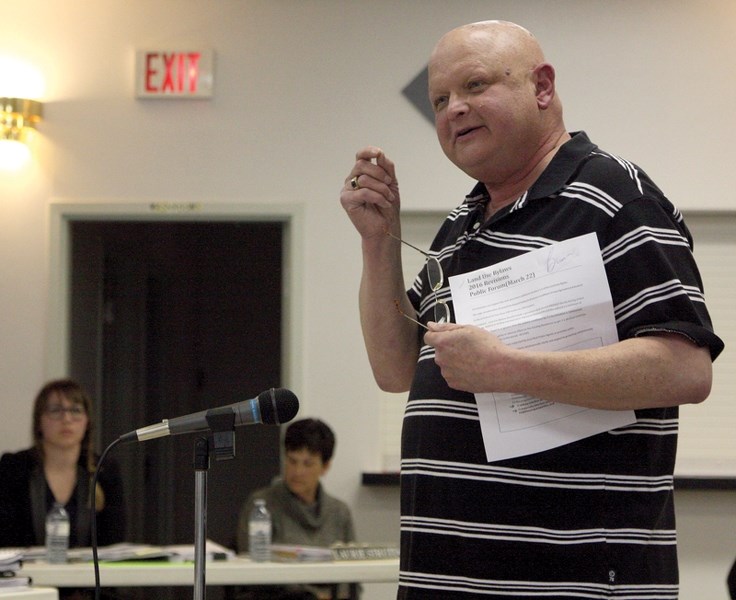Westlock County’s new municipal development plan (MDP) and land-use bylaw (LUB) will make its way back to the council table following a final round of public consultations last week.
Roughly 50 people crammed the Alberta Room at the Westlock and District Community Hall March 22 to speak for and against the documents — legislation which the county has been developing for the last two years.
Reeve Bud Massey said he was encouraged by the turnout and level of participation.
“There was a good mix of people. Some thought we were too liberal, some thought we were too restrictive,” Massey said.
“Some great ideas came out … some good ideas we’ll be considering.”
Council passed first readings of the documents March 8, prompting the public hearing. Consideration of second and third readings is expected to make the agenda at council’s next meeting on April 12.
Debate Tuesday mainly focused around the topic of acreages, which the bylaw more stringently regulates. Under the proposed legislation acreages would be limited to three per quarter section of land and can occupy no more than 20 acres combined.
Other major proposed changes include the addition of growth nodes — areas where the municipality sees industrial and commercial potential and includes all county hamlets, regulate RV storage and sea cans.
The documents also encourage regional cooperation, protection of resources and maintaining and improving municipal infrastructure.
Acreage proponents argued they want to see the county key in on providing acreage living opportunities for those who want it, while some farmers want to see a moratorium on subdivisions calling it a cash grab and claiming they prohibit their “right to farm.”
Farmer William Punko said legislation should protect farmers against acreage owners that want the rural lifestyle, but are bothered by farming activates.
“We feel that the right to farm should not only be protected through the use of policies to prevent fragmentation and re-designation, but also in rules to protect the actual activities required to farm,” Punko said.
“Without those rules … the policy to protect farmland becomes useless.”
Punko went on to propose that the county force acreage owners and tenants to sign a disclosure form that makes sure they understand what kind of farming activities to expect.
One resident said that the county shouldn’t stop farmers from subdividing their land into acreages.
“Land has many uses and should be encouraged through our land-use bylaw and municipal development plan. Provide the rules that will encourage economic development and growth, beyond the traditional agricultural pursuits,” the resident said.
“Provide the opportunity to live that rural lifestyle. Not everyone wants to live in urban areas or in the hamlets. Rural community is the best environment to raise a family, retire … live that good life.”
Massey, however, said the goal of the bylaw is to bridge the gap between those that want to live on acreages and preserving agricultural land.
“It’s attempting to find a balance. We have some people who are very adamant that we have absolutely no acreages, but we also have a large farm population that if we say to them: do you want us to tell you what you can do on your land? They say no,” he said.
“They’re not forced to sell, they’re not forced to create an acreage, but to take away their right to do that is a very serious thing. We’re trying to find that balance.”
Jarvie resident John Tyrrell questioned a new policy restricting sea can placement on properties for a maximum of six months, something Massey said is under review.
“Perhaps a six-month window is not the appropriate window,” Massey said.
“He was very persuasive. He made some very good points that need to be considered.”
Other issues raised included a proposal to extend setback distances of agricultural industrial land or rural industrial from 100 metres to 250 metres, ease requirements for developers who wish to construct multi-lot subdivisions and to further restrict acreages on the most fertile land.
CAO Duane Coleman said the next step is for the county’s consultants to collect the information and report back to council.
“Our planning consultants have to take and piece together what was brought out and bring some sort of recommendation to council,” Coleman said, adding he’s optimistic their recommendations would be ready for council’s upcoming April meeting.
“The intent was to bring it forward at our next council meeting. It depends on their workload.”



